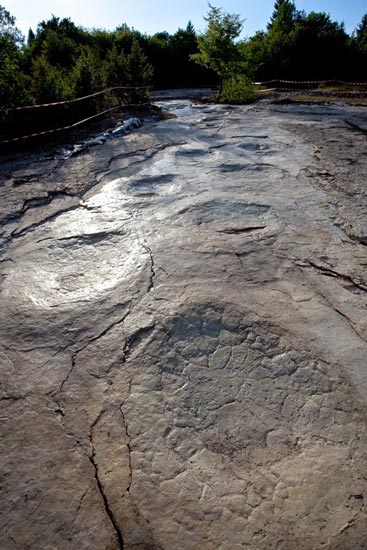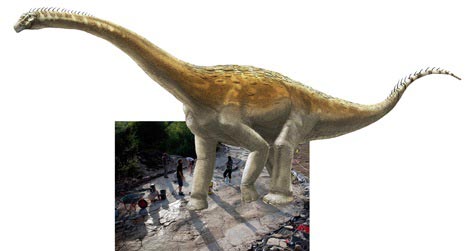Brontopodus plagnensis – New Ichnospecies Named for Giant Sauropod Tracks
A series of dinosaur footprints, made by a giant, long-necked, plant-eating dinosaur have been assigned an ichnospecies name. The tracks from the Jura plateau of France, located near the village of Plagne not too far from the Swiss border are, at around 155 metres in length, the longest sauropod trackways known to science. The ichnospecies has been named Brontopodus plagnensis, this translates as “thunderfoot of Plagne”. The ichnogenus Brontopodus has had a number of ichnospecies assigned to it already, including tracks from the southern United States and dinosaur footprints found in Early Cretaceous rocks in China.
A View of Part of the Sauropod Trackway
Picture credit: P. Dumas/Centre National de la Recherche Scientifique
To read an article about sauropod tracks found on the Isle of Skye: Isle of Skye Sauropods and their Water World.
Enormous Stride Length = Enormous Dinosaur
The stride length of this huge sauropod has been measured at 2.7 metres, the dinosaur was walking at around 4 kilometres/hour, which means that the average human would have had no trouble keeping up with it, however, you might have had to jog alongside, as its huge strides would have meant that it covered a great deal of ground with every pace. From the footprints, the scientists, which included French palaeontologist Jean-Michel Mazin, have calculated that this dinosaur might have been around 35 metres in length and weighed perhaps as much as forty tonnes.
Early Tithonian Trackways
The research team, writing in the journal “Geobios” have precisely dated the tracks to the Early Tithonian faunal stage of the Late Jurassic, the prints are approximately 150 million years old. The footprints show varying degrees of preservation along the trackway, the palaeoenvironment has been described as a littoral mudflat, a flat area close to a shoreline.
During the Late Jurassic, much of western Europe was covered by a warm tropical sea, the presence of large dinosaurs indicates that there must have been enough food resources on the archipelago of islands in the area to sustain megaherbivores. Perhaps, these tracks represent a dinosaur crossing mudflats at low tide walking between islands. Numerous dinosaur tracks are known from this region, including a series of tridactyl (three-toed prints), assigned to the ichnogenus Megalosauripus. The prefix ichno- is added when a taxon is described based solely on trace fossils of an animal, rather than on anatomical remains such as its bones and teeth.
An Illustration of Brontopodus plagnensis and an Estimation of Its Size
Picture credit: A. Bénéteau, photography Dinojura
To read Everything Dinosaur’s 2009 article about the original discovery of the trackways: On the Trail of Big Foot – Giant Sauropod Trackways Discovered in France.
The scientific paper: “The Dinosaur Tracksite of Plagne (Early Tithonian, Late Jurassic; Jura Mountains, France): The Longest Known Sauropod Trackway” by Jean-Michel Mazin, Pierre Hantzpergue and Nicolas Olivier published in the journal Geobios.
For dinosaur models and figures including sauropods: Dinosaur and Prehistoric Animal Models and Figures.








Leave A Comment